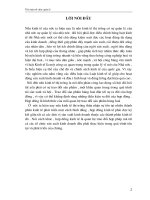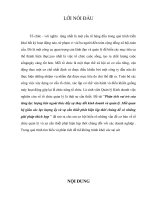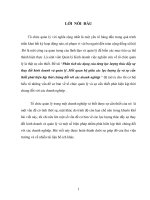Lý thuyết Thay đổi và Quản lý dựa vào kết quả
Bạn đang xem bản rút gọn của tài liệu. Xem và tải ngay bản đầy đủ của tài liệu tại đây (743.21 KB, 23 trang )
Theory of Change
&
Application of the Results Based Management approach
in
Program Design, Monitoring and Evaluation
By Nguyen Quoc Phong
Hanoi, July 08, 2016
Contents
Theory of Change
(TOC)
•
•
•
•
•
What is a TOC?
Why do we need a TOC?
How to create a TOC?
4 principles of TOC
What's the Difference
Between a TOC and a Logic
Model?
Results based management
(RBM)
•
•
•
•
What is a RBM?
Why do we need a RBM?
4 principles of RBM
How to do a RBM?
What is a TOC?
A hypothesized series of changes that are expected to
occur in a given context as the result of specific actions.
The TOC makes explicit how a program/activity design
team thinks outputs from their interventions will interact
with other concurrent interventions and contextual
conditions to stimulate or enable a series of outcomes
that will ultimately lead to the achievement of desired
objectives.
TOC Elements
Context for
the initiative
Diagram and
narrative
summary
Long-term
change
TOC
ELEMENTS
Assumptions
Process of
change
Why do we need a TOC?
• To develop a causal pathway to identify necessary
and sufficient outcomes needed to achieve a goal
• To develop a roadmap that shows how a set of
actions would help achieve a goal
• To identify and highlight interventions and
assumptions that are critical to produce an outcome
• To identify critical areas addressed by external actors
and how the project will link to them
How to create TOC?
1. Identify the long term goal.
2. Build the outcome map to identify the preconditions necessary
to achieve that goal.
3. Identify the interventions that your initiative will perform to
create these preconditions.
4. Develop indicators for each outcome that will be used to
assess the performance of the interventions.
5. Write a narrative that can be used to summarize the various
moving parts in your theory
TOC Conceptual Model
Project Level Goal
Purpose
Level
Outcome
Sub-Purpose
Outcome
Purpose
Level
Outcome
Purpose
Level
Outcome
Sub-Purpose
Outcome
Sub-Purpose
Outcome
Immediate
Outcome
Immediate
Outcome
Output
Output
Output
Immediate
Outcome
Output
Pathways of Change
Immediate
Outcome
Output
4 principles of TOC
Focus on
progress
Prioritise
leaning
Be
locally
led
Think
compass
not map
What's the Difference Between
a TOC and a Logic Model?
TOC Recaps
•
•
•
•
Strategic planning: TOC helps organisations practically to map the
change process and its expected outcomes and facilitates project
implementation.
Monitoring and evaluation: TOCs articulate expected processes and
outcomes that can be reviewed over time.
Description: TOC allows organisations to communicate their chosen
change process to internal and external partners.
Learning: TOC helps people to clarify and develop the theory behind
their organisation or programme.
What is a RBM?
RBM is a management approach and project Planning,
Monitoring, Evaluation & Reporting tool aimed at to improve
management effectiveness and accountability in achieving
developmental results.
RBM is focused on chain results: output, outcomes, and
impact.
RBM objectively measure how well results are being
achieved and report on measures taken to improve them.
It enable senior management and Project Management team
to judge if work is going in the right direction, whether
progress and success can be claimed, and how future efforts
might be improved on the basis of ground realities and data.
RBM is concerned with learning, risk management and
accountability.
The RBM life-cycle approach
What is Result
What we want?
Activities
How?
Inputs
Outputs
Outcomes
Results
Why?
Impact
Results chain
Traditional M&E Vs RBM
Traditional M&E
Focuses on inputs & Activities and
success is measured by status of
results
RBM
Focuses on internal results and
performance of organization in
producing developmental results
and positive changes in society.
Why do we need a RBM?
1. Improved focus on results instead of activities
2. Improved transparency, quality &
accountability
3. Improved measurement of programme
achievements (performance rather than
utilization)
4. Enhanced strategic focus
5. It is a global trend: using results-based
management to improve the efficiency of
development program
4 principles of RBM
1. Define expected results first and
activities later
2. Foster the active participation of
stakeholders
3. Ensure that all stakeholders work
towards achieving expected results
4. Apprise your work critically and learn
the lessons
How to do a RBM?
(Application RBM in Program Design, Monitoring and Evaluation)
1.
2.
3.
4.
5.
6.
7.
Analyzing problems and determining their causes;
Identifying measurable changes (results) to be achieved
based on problem analysis;
Designing strategies and activities that will lead to these
changes (results);
Balancing expected results with the resources available;
Monitoring progress regularly and adjusting activities to
ensure results are achieved;
Evaluating, documenting and incorporating lessons
learned into next planning phase;
Reporting on the results achieved and their contribution
to achieving goals.
How to depict the Results chain?
RBM Recaps
• RBM are good and useful techniques but it won’t
work itself and not sufficient to achieve results
• RBM depends on the organization's ability to create
a management culture that is focused on results.
• Manage change in your organization.
And, most of all, learn through our work
and reivise our theory with every lesson.
Q&A
References
• What is Theory of Change />• Fundamentals of Theory of Change
• Understanding theory of change in international development:
/>geSteinValtersPN.pdf
• Review of the use of ‘Theory of Change’ in international development:
/>7.pdf
• Results based management handbook, UNDP, October 2011
• Presentation of Barbara Reed & Dan Houston from USAID, October
2014
• Presentation of Mr. Fida Karim from IDARA, August 2015









